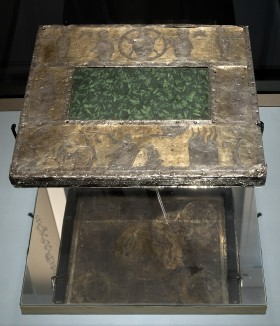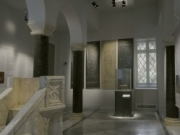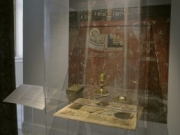

100 years Refugee Hellenism
The gardens of the Byzantine MuseumAthens Culture Net Find us on Facebook
Find us on youtube
Find us on instagram
Byzantine and Christian Museum :: Temporary exhibitions .::. Previous exhibitions
The Byzantine & Christian Museum is celebrating in 2014 the centenary of its foundation. In the context of scholarly activities that it organizes in common with Museums and Institutions worldwide, the Byzantine & Christian Museum collaborates with the Cluny Museum in Paris, one of the most important Museums in France dedicated to the Medieval Era, and is inaugurating an exhibition cycle under the general title “Byzantium and Medieval Western Europe″.
The purpose is the parallel presentation and the comparison of western and eastern artistic, theological, social and cultural aspects of the Middle Ages. In this particular exhibition we present an 11th century stone portable altar of western art with silver gilt revetment and relics of four Saints from the Cluny Museum and relevant objects from the Orthodox East i.e. antimensia made of textile and liturgical vessels, used during the Eucharist from the Collections of the Byzantine & Christian Museum.
Divine Liturgy
The Divine Liturgy is the main expression of the Christian devotion. Its most significant moment is the Holy Eucharist that represents the Last Supper and refers to Christ's sacrifice on the cross. After the conversion of bread and wine into Christ's body and blood, the sacrament of the Holy Communion is taking place. The sacramental acts are performed through the use of sacred vessels (chalice, paten, asterisk, spear, spoon, etc.) on the consecrated altar, in the sanctuary of the church, while hymns are chanted and scriptures are read. When it is necessary that the Holy Liturgy be done away from the church, the altar can be portable, like the stone plaque from the Cluny Museum or the textile antimensia from the Byzantine & Christian Museum Collections that are presented in the exhibition.
The Consecration of the Altar
According to the decrees of the Nicaea Oecumenical Synod (787), the altar on which the Eucharist is offered must be consecrated. This is obligatory for the fixed as well as for the portable altars because both of them have common symbolism and use. The consecration ceremony, a ritual rubbing with chrism (myrrh) in front of holy relics is performed by a bishop. The relics are placed in a specific socket or crypt underneath the fixed altar. When the altar is portable the relics are incorporated in it, as in the case of the western stone portable altar and of the eastern textile antimensia that are presented in the exhibition.
The portable Altar in the Latin Church
In the West the portable altars (petrae sacrae) are usually made from stone. In this way they commemorate the horizontal burial slabs that covered the tombs of the martyrs on which the early Christians used to perform the Holy Eucharist during ceremonies dedicated to the martyrs’ memory. The portable altars are items of small size, in order to reduce the weight and to avoid the danger of cracking. Their use was obligatory in the occasions that the Holy Liturgy had to be performed away from the church, during expeditions and wars, when rulers and their courts or missionaries used to travel in areas that had no churches, on boats etc. The earlier reference to a portable altar is found in Bede’s Historia Ecclesiastica gentis Anglorum: Two English missionaries that went to the Saxons in 692, brought with them holy vessels and a portable altar “tabulam altaris vice dedicatam”. According to the ritual of the Western Church (Decreta Authentica Congregationis Sacrorum Rituum), a consecrated altar, fixed or portable shall contain relics of two, at least, different saints; one of them has to be a martyr.
The antimension in the Eastern Church
In the Orthodox Christian Church of the East the antimension is used as a portable altar: as the word's etymology indicates (instead of mensa=table) it replaces the altar when it does not exist or when it is not consecrated i.e. it has not received the ritual rubbing with myrrh or it has no relics. As a portable item of small size it has been used widely during the turbulent eras like the Iconoclasm (8th-9th c.), while during the following centuries it became part of the fixed holy altar equipment. According to the Byzantine ritual, the presence of the antimension can make every place appropriate for the execution of the Christian worship with the intervention of the Saints, whose relics it contains, and of the Apostles. These are represented by the bishop who consecrates the antimension and offers it to the priest who will perform the Holy Eucharist.
Antimension: Form and symbolism
Antimensia from the Byzantine era are not preserved probably because of their sensitive material, but there is enough evidence for their existence in the Byzantine written sources. They are not made from stone, like the portable altars in the West, but from textile or wood like Theodore Studites mentions (circa 809). Gradually the linen fabric prevailed as handy material, which is also symbolically associated with the earth, where is the tomb of Christ, as Symeon of Thessaloniki in the early 15th century pointed out: An Antimension can replace the fixed altar only if it is consecrated by holy relics. These are fixed in a mixture of wax and gum and placed in a small pouch sewn into the back of the rectangular fabric. The front side is decorated with painted or printed symbolic scenes and inscriptions. Most common decorative motifs of Eucharistic or eschatological character are the Cross with the instruments of the Passion, the Christ-Lamb, Jesus Man of Sorrows (the Akra Tapeinosis), the Lamentation, the Holy Communion, etc. As the inscriptions mention unfailingly the year of dedication and the name of the bishop who made the consecration, they offer valuable information about church history and the establishment of patriarchal and episcopal lists.
petra sacra - antimension
The need to perform the Divine Liturgy in spaces outside the consecrated churches led very early in the use of the portable Holy Altar. The stone “petra sacra” in the West and the textile antimension in the East have common symbolism and use but differences in the material of which they are made. However, since the second quarter of the 20th century onwards the “antimensium latinum” is also widely used in the West, and is also made from textile, with holy relics attached.
The priests who follow the Byzantine ritual are permitted, if it is necessary, to perform the Divine Liturgy on a western petra sactra. But in the past, the priests that participated in the Synod of Ferrara-Florence (1438-39) were accused of performing the Divine Liturgy in a Latin Church, and they had pleaded that the rituals have been taken place on their own (i.e. eastern) antimension. On the contrary, Latin Clergy is not permitted to perform the Divine Liturgy on an antimension of the Eastern Orthodox Church, according to papal restrictions like those of 1742 and of 1917. It has been allowed only exceptionally, with texts of 1751 and 1755, to the missionaries in some regions of Eastern Europe such as Russia and Belarus.












